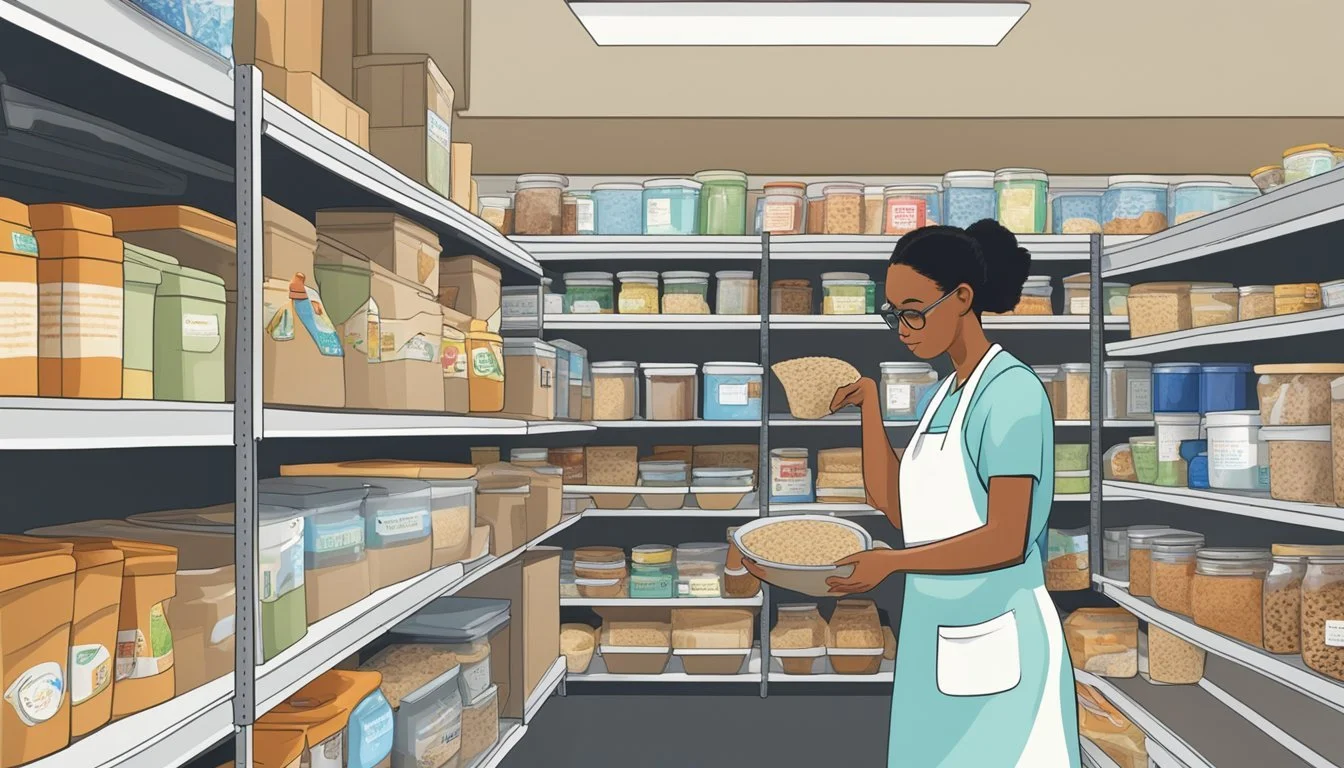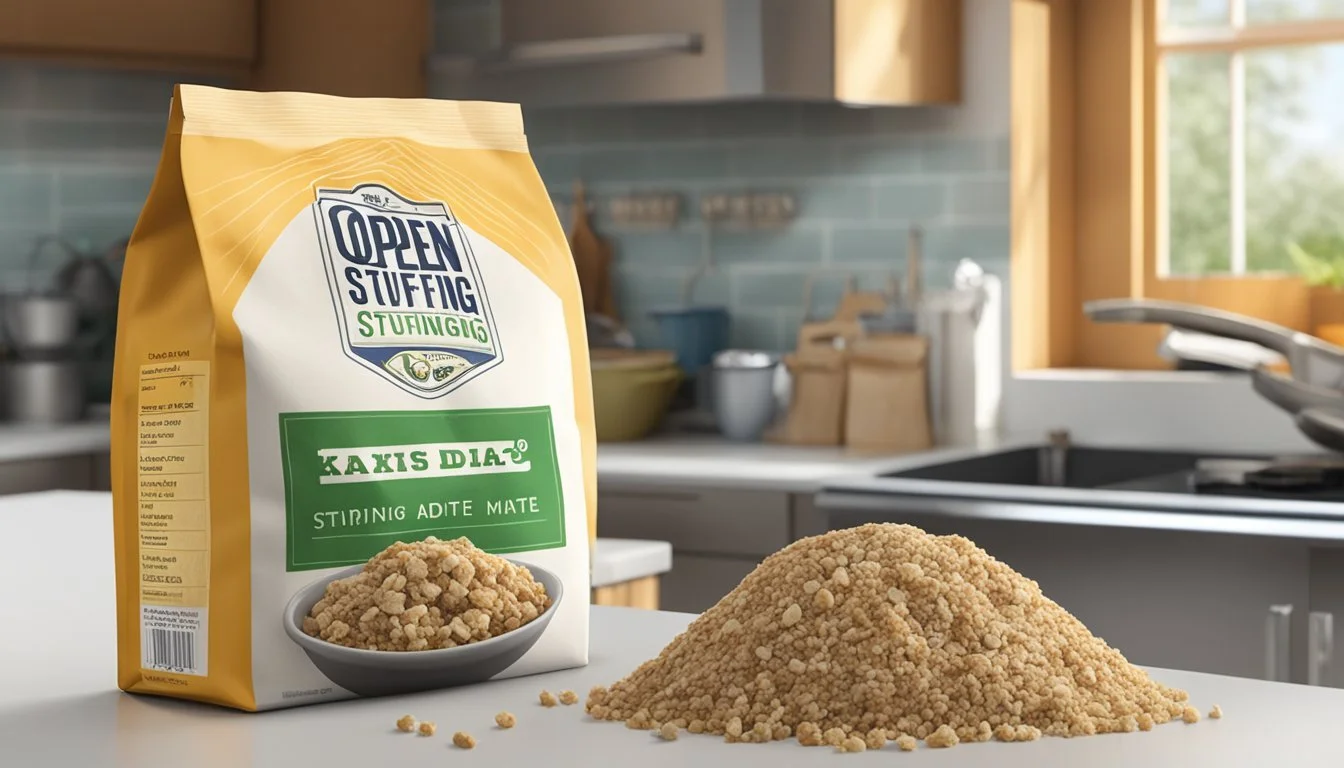Is it Safe to Prepare Expired Stuffing Mix?
Risks and Guidelines Explained
When sifting through pantry items and encountering an expired box of stuffing mix, the question of safety and quality comes to light. The primary concern is whether it is safe to prepare and consume stuffing mix that has passed its expiration date. As a generally dry product, stuffing mix is less prone to bacterial growth than moist, perishable foods. However, its quality and flavor are subject to decline over time, potentially leading to an unsatisfactory dish.
The shelf life of stuffing mix is influenced by factors such as storage conditions and the presence of preservatives in the product. Manufacturers often include a "best by" date to indicate the period within which the product is expected to retain its optimal quality. While an expired stuffing mix might not necessarily be unsafe to eat, its quality may have degraded. It is common practice to transfer the mix to an airtight container or resealable bag after opening to extend its shelf life.
Food safety experts suggest that as long as the stuffing mix has been stored properly—in a cool, dry place, and the packaging remains undamaged—it might be acceptable to use it beyond the expiration date. However, one should inspect the mix for any signs of spoilage, such as an off-odor or presence of mold, before deciding to use it. If any such signs are detected, the stuffing mix should be discarded to prevent the risk of consuming a potentially unsafe product.
Understanding Stuffing Mix and Its Components
Stuffing mix is a pre-packaged blend of dried bread cubes and seasonings that serves as a convenient shortcut for a traditional side dish. Typically, a stuffing mix contains ingredients such as:
Dried bread or croutons
Dried vegetables (e.g., onions, celery, carrots)
Herbs and spices (e.g., sage, thyme, pepper)
Salt
Preservatives
These components are selected for their ability to contribute to the overall flavor, texture, and quality of the final prepared dish. The bread gives stuffing its distinctive texture, while the blend of herbs and spices imparts the classic flavor profile many associate with holiday meals and comfort food.
In terms of shelf life, an unopened package of stuffing mix generally retains peak quality for roughly 12 to 18 months when stored correctly—in a cool, dry area away from direct heat or moisture. After this period, while it may still be safe to consume, the quality in terms of flavor and texture may diminish.
Here's a brief breakdown of storage expectations for stuffing mix:
State of Package Shelf Life Unopened 12-18 months Opened Approximately 2-3 months (if stored correctly)
After opening, transferring the stuffing mix to an airtight container or sealing it in a resealable plastic freezer bag can extend its usability.
The quality of stuffing mix is essential, not just for the enjoyment of the dish but also for food safety. Consumers should always verify the integrity of a stuffing mix's package before use and adhere to storage guidelines to maintain its shelf life.
Expiration Date and Food Safety
When considering whether to prepare expired stuffing mix, it's important to understand the impact of expiration dates on both quality and safety, and how to recognize if a food product has potentially become unsafe to consume.
The Significance of Expiration Dates
Expiration dates on food packages, including stuffing mix, are intended to indicate the last date the manufacturer guarantees the product’s optimal quality and freshness. They are not hard-and-fast safety cut-offs. Storing conditions play a critical role in preserving the quality of stuffing mix past its expiration date. A dry and cool storage environment can extend the longevity of a stuffing mix by several months.
Effects of Expiration on Quality and Safety
As stuffing mix ages beyond its expiration date, there may be a decline in flavor and texture. However, this does not immediately translate to a food safety issue. Consuming stuffing mix slightly past its date may not pose a health risk, but the consumer should be aware of diminishing quality. It is the presence of spoilage signs, not the expiration date alone, that often suggests a true health hazard.
Recognizing Spoilage and Food Safety Risks
Spoilage is a clear indicator that stuffing mix should not be consumed. Telltale signs include:
Smell: An off or unusual odor.
Appearance: The presence of mold or discoloration.
Texture: Any change in the expected dryness or coarseness of the mix.
If one observes any signs of spoilage, the stuffing mix should be discarded to avoid the risk of foodborne illness. Bacteria, such as salmonella or E. coli, are not generally detectable by sight, taste, or smell, so when in doubt, it is safer to err on the side of caution.
Proper Storage and Handling Techniques
Proper storage and handling of stuffing mix are critical to ensuring that it remains safe to eat even after its expiration date, provided it's stored correctly and the packaging is intact.
Storing Unopened Stuffing Mix
To maintain the quality and extend the shelf life of an unopened stuffing mix, storage in a cool, dry area is imperative. This usually means finding a spot in a pantry or cabinet that is away from heat sources and moisture, which could compromise the product's integrity. The ideal storage conditions involve:
Keeping the stuffing mix in its original packaging until it is ready to be used. If the packaging is robust and seals well after opening, it can continue to be used.
Ensuring the area is consistently cool, which typically means under room temperature, and the location is devoid of direct sunlight and other heat sources.
Checking that the area is dry to prevent moisture from seeping into the stuffing mix, which can create an environment conducive to bacteria growth and product spoilage.
Handling After Opening
Once the stuffing mix is opened, the approach to storage should change to ensure the product remains at best quality. An opened stuffing mix should be:
Transferred to an airtight container or a resealable plastic freezer bag to reduce its exposure to air and moisture.
Sealed tightly after each use to retain freshness.
Stored in the same cool, dry conditions as recommended for unopened packaging.
Proper handling also includes observing good hygiene practices, such as using clean utensils when serving or transferring the stuffing mix to prevent cross-contamination.
Cooking With Expired Stuffing Mix
Before using an expired stuffing mix, it is crucial to assess its quality and understand how cooking methods and temperature can affect its safety and palatability.
Assessing Quality Before Use
When considering an expired stuffing mix, a careful examination is mandatory to determine if it is safe to use. One should look for any signs of spoilage, such as:
Changes in color
Off-putting smells
Presence of mold
If any of these signs are evident, the stuffing mix should be discarded. Additionally, the expiration date provides an initial benchmark; a stuffing mix stored in a cool, dry place may last 6 months beyond this date. However, the absence of spoilage signs does not guarantee safety. Consumers should use their judgment and prioritize safety, especially with products like stuffing mix, which includes a mixture of dried grains and seasonings that could degrade over time, affecting both flavor and texture.
Cooking Methods and Temperature Impact
For an expired stuffing mix deemed acceptable in quality, cooking it thoroughly is the next step to ensure safety. The goal is to achieve a uniform internal temperature that is high enough to eliminate potential pathogens. The USDA recommends that all parts of the stuffing reach a minimum internal temperature of 165°F (74°C).
Oven-cooking: Evenly spread the prepared stuffing mix in a baking dish and cook as per the original directions, checking the internal temperature in several places with a food thermometer.
Stove-cooking: Bring the stuffing to a boil if prepared on the stove and maintain the temperature for the recommended cooking time.
Note: Expired stuffing mix may have an altered moisture content, which could potentially affect the cooking time. Consumers should be prepared to adjust the amount of liquid or the length of cooking time to achieve the right texture and flavor.
By following these careful assessment and cooking steps, cooks can maximize the chance that an expired stuffing mix will be both safe to consume and palatable.
Freezing and Refrigerating Stuffing Mix
When preserving the freshness of stuffing mix, freezing and refrigerating are viable options. Storing in the freezer can significantly extend the product's lifespan beyond the "best by" date, provided it is done correctly.
Freezing: To freeze stuffing mix, one should ensure the product is unopened or securely transferred into a freezer-safe bag or container. An airtight freezer bag is recommended to prevent the mix from absorbing other odors and becoming stale. This method can help maintain quality for future use and is particularly useful for extending the longevity of the stuffing mix.
Refrigerating: Refrigeration is not commonly recommended for dry stuffing mixes unless the package has been opened. Once opened, it's advisable to place the stuffing mix in an airtight container to prevent moisture from getting in, which could result in spoilage.
Reheating: When ready to use, stuffing mix that has been frozen should be thoroughly thawed before preparation. If refrigerated, ensure that it has been kept in a consistent temperature environment to maximize its freshness.
Preservation Method Description Tips Freezing Extends storage life efficiently Use airtight freezer bags Refrigerating Keeps opened product fresh for a shorter time Store in airtight containers Reheating Necessary after freezing before preparation Thaw completely, ensure freshness
One should always check for any changes in the mix's appearance or smell, which may indicate spoilage. If there are any signs of degradation, it is safer to discard the mix.
Monitoring and Recognizing Spoilage
When examining expired stuffing mix, one must look for signs of spoilage that can indicate whether the product is no longer suitable for consumption. Spoilage can be identified through visual and olfactory indicators, as well as changes in taste and texture.
Visual and Olfactory Indicators
Mold Presence: Mold, which can appear in various colors, is a critical indicator of spoilage. If visible mold or any unusual specks are present, the stuffing should be discarded.
Color: Discoloration is a sign of degradation. Stuffing that has deviated from its original color could indicate spoilage.
Odors: Any off or rancid smells are a direct indication that the stuffing mix should not be used. A wholesome stuffing mix should not emit any robust or stale odors.
Taste and Texture Changes
Taste: Should one taste the stuffing before detecting spoilage through other methods, a tangy or off flavor can signal that the stuffing has gone bad.
Texture: An alteration from the normal texture, such as an unexpected sogginess or dryness, can also be indicative of spoilage, possibly due to improper storage conditions.
By paying close attention to these factors, consumers can confidently discern the quality and safety of expired stuffing mix.
Incorporating Expired Stuffing Mix in Recipes
When utilizing expired stuffing mix, one must first ensure safety and quality. If the mix is past its expiration date but shows no signs of spoilage—no off smells, mold, or discoloration—it might still be incorporated into various recipes with caution.
Here's how to use expired stuffing mix creatively:
Casseroles: They can acquire additional texture and flavor with the inclusion of stuffing mix. If the mix is dry, it can serve as a crunchy topping; if slightly stale, it can be moistened with broth before layering.
Meatloaf: Incorporating stuffing mix into meatloaf can add structure and seasoning. It's a simple modification; substitute breadcrumbs with an equivalent amount of stuffing mix.
Vegetables: Stuffed vegetables, like bell peppers or zucchini boats, can benefit from expired stuffing mix. Combine it with grains, chopped vegetables, or fruits for a savory filling.
For recipes requiring moisture:
Soups: An expired but still good stuffing mix can thicken soups. It should be added towards the end of cooking to avoid over-saturation.
Side Dishes: Expired stuffing mix can complement dishes that involve grains. Mixed with rice or quinoa, it adds seasoning and variety.
Recipe Tips:
Stale Stuffing: Mix with fresh herbs and use as a base for roast meats.
Crumbly Mix: Great as a breading for fried vegetables or meats.
Seasoning: Some expired stuffing can still be a powerhouse of flavors, ideal for adding a punch to dishes that need more character.
Always taste a bit of the rehydrated mix before adding it to your dish to ensure the flavor profile is still acceptable. Cook all dishes thoroughly to ensure food safety.
Food Safety Questions and Answers
When approaching the topic of expired stuffing mix, one must consider food safety guidelines and the risk of foodborne illness. This section addresses common concerns with factual answers grounded in food safety practices.
Can You Eat Expired Stuffing Mix?
The consumption of expired stuffing mix hinges on its storage conditions and the integrity of the packaging. If the mix is unopened and stored in a cool, dry place, it could be safe to eat for several months past its expiration date. However, visual and olfactory checks are crucial; any signs of spoilage like an off smell or presence of mold indicate that the stuffing mix should not be consumed.
How to Prevent Foodborne Illness?
To mitigate the risk of foodborne illness, always handle stuffing mix with care by following these steps:
Storage: Keep the mix in a cool, dry place away from contaminants.
Cooking: Cook stuffing to a minimum internal temperature of 165 °F, as measured with a food thermometer.
Temperature Safety: Do not consume stuffing that has been in the 'danger zone' (40 °F to 140 °F) for over two hours, as bacteria grow rapidly in this range.
Is It Worth the Risk?
Evaluating the health risks against the desire to use an expired product, one should err on the side of caution. When in doubt, it is safer to discard the expired mix rather than risk the potential of food poisoning, which is particularly dangerous for vulnerable populations such as young children, the elderly, and those with compromised immune systems.
Specific Considerations for Stuffing with Perishable Ingredients
When preparing stuffing that includes perishable ingredients like meat, poultry, shellfish, or giblets, safety must be prioritized to prevent bacterial growth and the risk of salmonella or other foodborne illnesses. It is essential to use a food thermometer to ensure that the center of the stuffing reaches a minimum internal temperature of 165°F, as harmful bacteria are known to thrive between 40°F and 140°F.
If the stuffing contains any raw meat or seafood, it should be mixed with other ingredients immediately before being cooked. Stuffing should not be prepared ahead of time and must be cooked soon after mixing to mitigate bacterial proliferation. If the perishable ingredients are stored improperly or for too long, even before adding to the stuffing, the risk of contamination increases.
The poultry cavity can act as an incubator for bacteria. For this reason, it is recommended to cook stuffing separately from poultry or, if cooked inside, to ensure that both the poultry and the stuffing reach the safe temperature of 165°F throughout. This is also true for leftovers:
Refrigerate leftover food: All remaining perishable leftovers including prepared stuffing should be refrigerated within two hours of cooking.
Storing leftovers: Leftovers should be packed in shallow containers to cool evenly and prevent bacterial growth.
In short, while expired stuffing mix might be safe to prepare if it's a dry mix and stored properly, the caveat is that the perishable ingredients that are often mixed into the stuffing must be fresh and handled correctly to maintain food safety.
Conclusion
When it comes to expired stuffing mix, the key considerations are food safety and quality. Manufacturers provide a "best by" date to indicate the time frame in which the product is expected to maintain its peak quality. While this is not an expiration date, consumers should use it as a guideline for optimal taste and texture.
Storage Tips:
Keep the mix in a cool, dry environment.
Once opened, transfer it to an airtight container or resealable plastic bag.
Beyond the "best by" date, stuffing mix can still be used, assuming it has been stored correctly and shows no signs of infestation or a rancid smell. A high salt content naturally preserves dry stuffing mix, reducing the speed at which quality deteriorates.
Before preparing a meal with expired stuffing mix, one should inspect the mix and perhaps even rinse any raw ingredients that are included. If there is any uncertainty about the product's quality, it's prudent to err on the side of caution, especially when planning for a holiday meal where expectations and stakes are often high.
In essence, expired stuffing mix can be acceptable for use if it passes a thorough quality check. However, safeguarding food safety should always take precedence over utilizing expired products. Consumers are encouraged to follow these guidelines to ensure both a delicious and safe dining experience.










